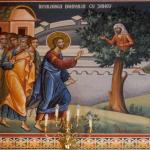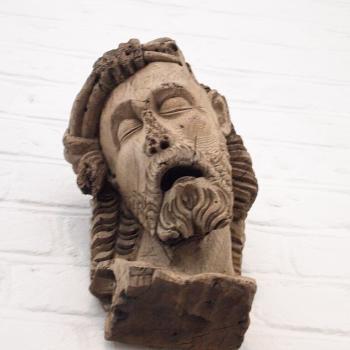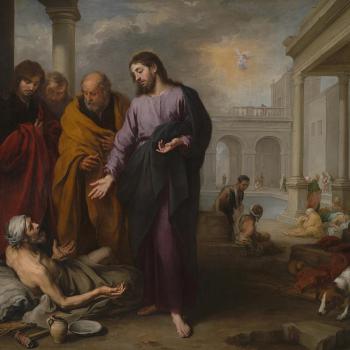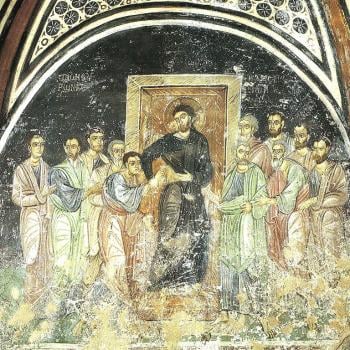
The body of Christ is experienced by the faithful both in relation to their communion with each other (and in this way, as the church), as well as in their reception of the eucharist. The historical, empirical manifestation of each signifies the greater reality which lies beyond what is perceived through their physical experience; that is, what is perceived is symbolic, though it must also be understood that such symbol also participates in the reality which is represented by it (so that the symbol is at once the thing which is symbolized, though the thing symbolized is more than what is perceived in the empirical phenomenon involved with the symbol). The historical institution of the church is the church, though there is more to the church than the institution itself; the physical manifestation of bread and wine in the eucharist serves to represent the special food and drink which is had by those who partake of it. Each likewise represents a way in which the faithful participates in and unites themselves to the body of Christ, thereby making them a part of that body itself.
The church is the Body of Christ, and everyone is called to be a part of that body, to be brought into Christ and receive the deifying graces which Christ shares with all those who are united with him. The reason why the church is called Catholic is because it calls everyone and everything unto itself: “‘Church’ (ecclesia) is a Greek word that is translated into Latin as “convocation” (convocation), because it calls (vocare) everyone to itself.” [1] Everyone is called to the Body of Christ. Everyone is meant to share in deifying graces, to be incorporated into Christ, to transcend their individualistic self-isolation by embracing communion, communion with the rest of humanity, and indeed, with the rest of the world, and likewise, communion with God. Individualism runs contrary to nature because it runs contrary to the communion on which nature itself is founded. Everyone has their existence coming from outside of themselves, and so they participate in existence through communion with the source and foundation of existence itself. Individualism, which tries to embrace the individual and lift it up apart from all things outside of the individual itself, cuts itself off from communion, making those who follow such individualism less than what they could and would be if they but opened themselves up to what lies beyond themselves.
The church, therefore, represents the universal call of being itself, the call for all created beings to be one so that in and through that unity, a united established by communion, they will be united with the source and foundation of being itself (God). The eucharist brings forth such communion, so that those who properly partake of it not only find themselves becoming that which they eat, the body of Christ, they find themselves joining in and becoming one with all others who partake of the eucharist as well. The external representation of this is found in the way the eucharistic bread is made of many grains and yet come together to form one sacramental reality (no matter how many grains are used, the reality is always one and the same, so that all the people together, likewise, become one; no matter how many people are brought together in a particular community, the reality of the church remains one and the same). Liturgy and communion allow us to have real participation and unity with the body of Christ, but it does so in a symbolic form; it is a real symbol, to be sure, but it is still a symbol, pointing to an eschatological truth. This is why it is said that in the eschaton, the symbolic element will no longer be necessary:
The body of Christ is received presently under an appearance, that is, sacramentally, in order to signify that union by which we will be conformed to God. This will happen when we will see Him as He is. Nevertheless, those who receive [the Eucharist] worthily do not receive less than the reality itself. And it is not surprising that this receiving [of the body of Christ] is a sign of some union, considering that all things whatsoever that are in the Church on earth are signs of future realities. For in the future there will be no things that are signs of other things. And this is what it means to receive by the truth of the reality, that is, not figuratively. [2]
In the eschaton, the faithful will still partake of the reality of the eucharist, but they will no longer need to do is in the manner which was needed in history. That is the reality will be the same, but in the eschaton, it will be apprehensible in a way that the accidents (physical phenomena) associated with the eucharist will not be necessary.
In the eschaton all will be in all, for all things will realize their communal nature, and God’s deifying grace will be spread through all things. The liturgical celebration of the faithful is meant to point to and represent this even as it allows those who partake of the eucharist to receive the eschatological reality and participate in it in their temporal existence; in and through communion, the faithful are able to realize the immanence of the eschaton As they do this they should realize that the church in which they find themselves in, thanks to such communion, is both a transcendent eschatological reality as well as a historical, immanent reality which manifests and represents that eschatological reality. For this reason, just as they must not confuse the accidents of communion with its essence, so they must be careful and not confuse the accidents of the church in its historical manifestation as the essence of the church itself:
The Church is given on the part of God, but its historical being is only possibly manifested in an analogical way, according to the degrees of mimesis/participation in the christological energies proposed by the Spirit to her members: the Church is always in the making. [3]
Sadly, it is in the midst of the accidents by which we perceive the historical manifestation of the church, accidents which includes its institutions, we find various imperfections. This is one of the many reasons why we must not confuse the accidents with the essence, because that will mean all those imperfections are eternally necessary. Nonetheless, we should also recognize that despite such imperfections, the presence of the eschatological glory is shared to the world in and through the church. We must not limit grace to the institutional manifestation of the church but accept, with Bulgakov, that grace, and therefore, the church itself in some fashion transcends those institutions:
In reality, Christianity served as the spiritual leaven for a new society, for in it was born a new sort of personhood, and its actual influence reached, of course, far beyond the limits of the activities of the Church’s own institutions. What is more, it is impossible to deny that Church communities, as is the case with the rest of humanity, rarely ever lived up to the height of their calling. Furthermore, they often became a stronghold of conservativism, or, at all events, of unprogressive attitudes, both externally and internally. [4]
This, of course, does not deny the value and necessity of such institutions, but rather, it denies the way we would read them as being univocal with the essence of the church itself. This is why the institutions and their functions can and do change over time, sometimes for the better, sometimes for the worse, without affecting the sacramental truth of the church itself. The church is a sacrament, and as a sacrament, it brings the presence of Christ to the world, a presence which transcends the physical, accidental form we find the church presents itself in a given age while nonetheless still immanent with it (just as the real presence of Christ is always present through the eucharist despite the way that presence is received through the accidents of bread and wine).
The body of Christ, the reality of the presence of Christ, comes to us in forms which allow us to be one with it. We are given ways to engage that unity through symbols which participate in the reality which is being symbolized, but because of this, we must be careful and understand the part which is the external symbol and that which is the reality that lies beyond the symbol itself, and not confuse the two. It is such confusion, which happens often throughout history, which hinders the church from being all it can be, as such confusion will not allow the institutions of the church to be reformed but rather defended despite the problems inherent within them. Such defense, likewise, has many people who see the problems within the institution flee from the church itself, for they believe the defense that the institution as it is represents what the church must be like, and if it must be like that, they want nothing to do with it. Apologetics, if it is always defensive without accepting and affirming the problems many have with the institution itself, instead of defending the church, serves to hold it back, even as many of those who otherwise are critical of the church are the ones who stand for its greater, transcendental character and are the ones who will most likely do what apologists say they want to do, which is attract people to the church itself.
[1] St. Isidore of Seville, The Etymologies of Isidore of Seville. Trans. Stephan A. Barney, W.J. Lewis, J.A. Beach and Oliver Berghof (Cambridge: Cambridge University Press, 2006; revised, 2010), 173.
[2] Robert of Melun, “Questions on the Divine Page,” in Interpretation of Scripture: Practice. Trans. Franklin T. Harkins. Ed. Frans van Leiere and Franklin T. Harkins (Turnhout, Belgium: Brepols, 2015), 302.
[3] Nikolaos Loudovikos, Church In the Making: An Apophatic Ecclesiology of Consubstantiality. Trans. Normal Russell (Crestwood, NY: St Vladimir’s Seminary Press, 2016), 58.
[4] Sergius Bulgakov, “The Soul of Socialism (Part II)” in The Sophiology of Death. Essays on Eschatology: Personal, Political, Universal. Trans. Roberto J. De La Noval (Eugene, OR: Cascade Books, 2021), 36.
Stay in touch! Like A Little Bit of Nothing on Facebook.
If you liked what you read, please consider sharing it with your friends and family!













